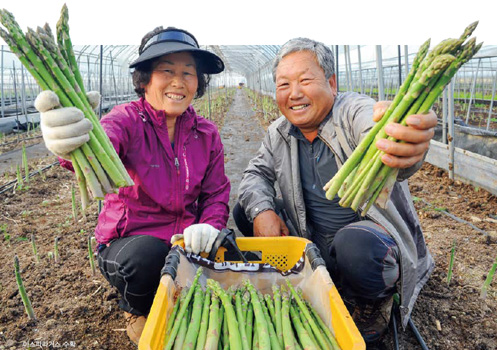Cultivating New Varieties Suitable for Gangwon State
For the sustainable future growth of Gangwon agriculture, we are responding to climate change by cultivating various varieties that suit the tastes of consumers and distributing them to farmers.
Gangwon state Agricultural Research & Extension Servies cultivates around 50 varieties of 15 crops suitable for our state, including rice, grains, corn, and fruit trees, every year and distributes them to farmers. A production complex is created for the cultivated varieties to promote early distribution, and support is provided to develop them into regional customized specialty procucts in cooperation with industries.
- Breeding Superior New Varietes with Taste and Functionality
- Distribution of Superior Varieties by Creating a Pilot Complex
Turning Regional Customized Specialty Crops into Premium Products
We are focusing on developing promising new crops for each region to cultivate specialty items appropriate for local conditions and establishing a stable production system to improve the income of farmers.
In response to increased agricultural imports and changes in consumption, we are improving farm income and establishing a foundation for stable production by developing processed horseradish products as regional specialty items and through the forcing culture of Aralia cordata during the off-season. In addition, we are continuously discovering and distributing new income-generating crops for our state by cultivating apples and asparagus in the Yeongseo region (west of the Taebaeksan Mountain range) and strawberries and cherries in the Yeongdong region (east of the Taebaeksan Mountain range).
- Development of Promising New Crops
Development of new crops such as wild vegetable Aralia sprouts (dureup in Korean) tailored to comsumer tastes and production of superior ginger bulbs with no replant failute - Scaled-up Regional Customized Specialty Items and Increased Competitiveness
Creating a foundation ofr regional specialty products gy cultivating competitive crops in each city and county, such as apples in Yanggu0gun and cherries in Wonju-si.
Response to Climate Change, Strengthening the Stable Production of Agricultural Products
In order to cope with increased agricultural disasters due to abnormal weather, such as abnormal low temperatures and heavy rains, we havea comprehensive cultivation system and support enhancing the quality of livestock products.
In response to climate change and reduced manpower due to an aging rural population, we are providing cutting-edge new technologies for unmanned automation and disater reduction. High-temperature reduction technology such as a water spray system is applied to vegetables, and facilities to prevent damage from high and low temperatures such as defrosting fans and sun protection nets are installed in orchards. The quality of livestock is improved by managing the environmet with ICT.
- Distribution of New Technologies to Cope with Abnormal Weather and Reduced Manpower
- Fog cooling system, Sun protection net, Potato harvester - Focus on Stable Production and Quality Improvement of Livestock
Establishing a System for the Timely Control of Crop Diseases and Pests
To prevent the inflow and spread of pests and diseases due to international exchanges and global warming, we are promoting quick pest and disease diagnosis centered on the field and public pest control.
Agricultural Researh & Extension Services has installed forecasting and observation plots in cities and counties and is operating a crop forecasting and control team for the rapid forecasting and timely control of crop pests and diseases. Preemptive cehmical pest control is carried out, and an infection forecasting system is used for quarantine pests and diseases such as fire blights and cyst nematodes, and sudden pests such as metcalfa pruinosa are dealt with proactively in cooperation with the Forest Departments.
- Forecasting and Timely Control of Crop Diseases and Pests
- Diagnosis of Diseases and Pests and Strengthening of Pest Control Capabilities
 최종수정일 : 2025-02-26
최종수정일 : 2025-02-26








